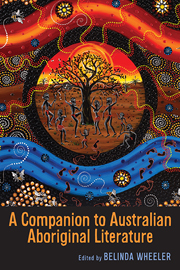Book contents
- Frontmatter
- Contents
- Foreword
- Acknowledgments
- Chronology
- Introduction: The Emerging Canon
- 1 Indigenous Life Writing: Rethinking Poetics and Practice
- 2 Australian Aboriginal Life Writers and Their Editors: Cross-Cultural Collaboration, Authorial Intention, and the Impact of Editorial Choices
- 3 Contemporary Life Writing: Inscribing Double Voice in Intergenerational Collaborative Life-Writing Projects
- 4 European Translations of Australian Aboriginal Texts
- 5 Tracing a Trajectory from Songpoetry to Contemporary Aboriginal Poetry
- 6 Rites/Rights/Writes of Passage: Identity Construction in Australian Aboriginal Young Adult Fiction
- 7 Humor in Contemporary Aboriginal Adult Fiction
- 8 White Shadows: The Gothic Tradition in Australian Aboriginal Literature
- 9 Bold, Black, and Brilliant: Aboriginal Australian Drama
- 10 The “Stolen Generations” in Feature Film: The Approach of Aboriginal Director Rachel Perkins and Others
- 11 A History of Popular Indigenous Music
- Notes on the Contributors
- Index
9 - Bold, Black, and Brilliant: Aboriginal Australian Drama
Published online by Cambridge University Press: 05 September 2013
- Frontmatter
- Contents
- Foreword
- Acknowledgments
- Chronology
- Introduction: The Emerging Canon
- 1 Indigenous Life Writing: Rethinking Poetics and Practice
- 2 Australian Aboriginal Life Writers and Their Editors: Cross-Cultural Collaboration, Authorial Intention, and the Impact of Editorial Choices
- 3 Contemporary Life Writing: Inscribing Double Voice in Intergenerational Collaborative Life-Writing Projects
- 4 European Translations of Australian Aboriginal Texts
- 5 Tracing a Trajectory from Songpoetry to Contemporary Aboriginal Poetry
- 6 Rites/Rights/Writes of Passage: Identity Construction in Australian Aboriginal Young Adult Fiction
- 7 Humor in Contemporary Aboriginal Adult Fiction
- 8 White Shadows: The Gothic Tradition in Australian Aboriginal Literature
- 9 Bold, Black, and Brilliant: Aboriginal Australian Drama
- 10 The “Stolen Generations” in Feature Film: The Approach of Aboriginal Director Rachel Perkins and Others
- 11 A History of Popular Indigenous Music
- Notes on the Contributors
- Index
Summary
Performance, as an embodied encounter, between people of different cultures occupies a crucial position within the processes of recognition and misrecognition of the other. In the context of colonized peoples, dramas written for performance in effect act as a map for representations and communication. In Australia, performance has been a pivotal point of encounter between Aboriginal and non-Aboriginal people. Historical aboriginal cultures are probably the most performance based in the world. Explicitly choreographed performances marked every aspect of social, political, and spiritual life, ranging from judicial, religious, diplomatic, and pedagogical practices to hundreds of genres of performances for entertainment. These performances combined dialogue, poetry, mime, song, dance, musical accompaniment, and visual art. As a central and striking feature of Aboriginal cultures, these practices were a crucial point of cross-cultural exchange from the first European colonial settlements in the late eighteenth century.
Throughout the nineteenth century Aboriginal people created and performed shows for the European settlers for a variety of reasons, including proclaiming Aboriginal sovereignty of the land, communicating their culture to the settlers, and engaging with the settler economy. Examples of the creation and performance of these shows are numerous. In his 1865 publication, The Aborigines of Australia, Gideon Lang recounted a performance text from the early 1840s (28–29). Lang, a settler who migrated to Australia in 1841, brought together various accounts of a diplomatic event that occurred in Queensland: Bussamarai, a leader of the Mandandanji people, invited the leading settlers to watch a performance that was intended to communicate their fate if they did not leave the area.
- Type
- Chapter
- Information
- A Companion to Australian Aboriginal Literature , pp. 155 - 172Publisher: Boydell & BrewerPrint publication year: 2013



